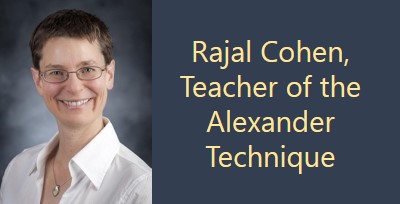
Home
Description
Lessons
Bio
Resources
The Alexander Technique is for:
- Unlearning Harmful Habits
- Stress Reduction
- Easy Elegant Posture
- Mindfulness
- Public Speaking
- Computer Use
- Aging Gracefully
- Music Performance
- Dance & Athletic Performance
- Recovering from Repetitive Strain Injury
- Preventing Neck & Back Pain
- Natural Free Breathing
Trying is only emphasizing the thing we know.
- F.M. Alexander
The Problem
Many factors can cause our movement and posture to be less than ideal. We may imitate the attitudes of people we admire. We may find ways of walking that downplay some feature of our bodies that we don’t want to draw attention to. We may develop a stance designed to communicate a message to people around us that we are laid-back, or tough, or charming, or cool, or non-threatening, or a go-getter. In order to live up to these ideals, we shut ourselves off from physical sensation, so that we don't notice the subtle hints our body is giving us, and we don’t realize that we are doing something unhealthy to ourselves.
As these externally-imposed movement patterns become habitual, we forget how to be easy, graceful and light, and we may even forget that we ever knew. Performance suffers, as does our ability to find delight in being embodied. We struggle with aches and pains, and we injure ourselves too often.
The “Alexander Technique” is a set of powerful ideas and tools for improving mind-body unity, especially with respect to movement, posture, and activity. An Alexander Teacher uses these tools to teach students how to better enjoy living in their bodies.
People do not decide their futures; they decide their habits, and their habits decide their futures.
- F.M. Alexander
Comparison to other Somatic Practices
Chiropractic and Osteopathy
The Alexander Technique shares with these methods an interest in the bones being in right relationship to each other,
so that they can effectively transfer the weight of the body and meet the earth's force. However, lessons in the Alexander Technique do not include "adjustments." Instead, students learn how to prevent the ways of thinking, holding themselves, and moving that led them to want or need adjustments in the first place.
Yoga, Pilates and Tai Chi
Although the Alexander Technique shares with these practices a goal of reaching a balanced, centered state with fluid movement and easy breath, the method is very different. Instead of focusing on a particular set of movements to do every day, the Alexander Technique gives the student the skill to analyze any movement - from simple walking to a challenging yoga pose - and figure out how to execute it with greater ease.
Massage and Bodywork
Although students usually find the brief "table-work" segment of an Alexander Technique lesson pleasant and relaxing, it is quite different from massage. It is done fully clothed, and it does not include any of the stroking, kneading or tapping that generally characterize massage. Rather, it is another context in which to practice being aware of movements and tensions and to make conscious choices about them.
Prevent the things you have been doing and you are half-way home.
- F.M. Alexander
Who was F.M. Alexander?
F.M. Alexander (1869-1955) was a young Shakespearean actor touring in Australia and Tasmania, when a recurring hoarse voice threatened to put an end to his burgeoning career. After unfruitful consultations with several doctors and voice teachers, he began to consider his approach to speaking and reciting. Through years of rigorous self-observation and experimentation, he solved his problem, developed a full, rich voice, and developed the Alexander Technique.
Contact Rajal at 208-882-1844 or rajal.cohen@gmail.com,
or visit Rajal's Main Page

